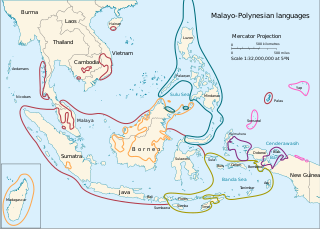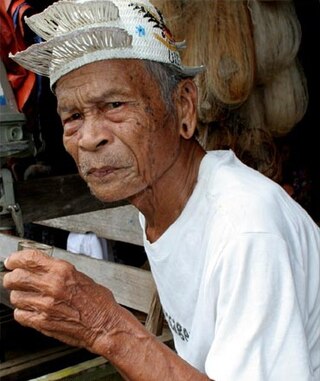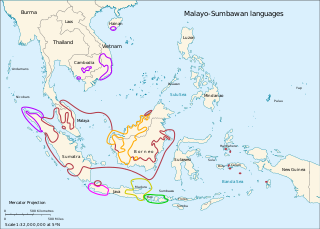Related Research Articles

The Malayo-Polynesian languages are a subgroup of the Austronesian languages, with approximately 385.5 million speakers. The Malayo-Polynesian languages are spoken by the Austronesian peoples outside of Taiwan, in the island nations of Southeast Asia and the Pacific Ocean, with a smaller number in continental Asia in the areas near the Malay Peninsula, with Cambodia, Vietnam and the Chinese island Hainan as the northwest geographic outlier. Malagasy, spoken in the island of Madagascar off the eastern coast of Africa in the Indian Ocean, is the furthest western outlier.
Rejang or Rejangese may refer to:

Punan Bah or Punan is an ethnic group found in Sarawak, Malaysia and in Kalimantan, Indonesia. The Punan Bah people are distinct and unrelated to the semi-nomadic Penan people. Their name stems from two rivers along the banks of which they have been living since time immemorial. They do have other names: Mikuang Bungulan or Mikuang and Aveang Buan. But those terms are only used ritually these days.
Melanau or A-Likou is an ethnic group indigenous to Sarawak, Malaysia. They are among the earliest settlers of Sarawak. They speak in the Melanau language, which is a part of the North Bornean branch of Malayo-Polynesian languages.
The Murutic languages are a family of half a dozen closely related Austronesian languages, spoken in the northern inland regions of Borneo by the Murut and Tidung.
The Kayanic or Kayan–Murik languages are a group of Austronesian languages spoken in Borneo by the Kayan, Morek Baram, Bahau, and related peoples.
The Melanau–Kajang languages or Central Sarawak languages are a group of languages spoken in Kalimantan, Indonesia and Sarawak, Malaysia by the Kenyah, Melanau and related peoples.
The Kenyah languages are a group of half a dozen or so closely related languages spoken by the Kenyah peoples of Borneo. They are:
The Barito languages are around twenty Austronesian languages of Indonesia (Borneo), plus Malagasy, the national language of Madagascar. They are named after the Barito River located in South Kalimantan, Indonesia.
The Greater North Borneo languages are a proposed subgroup of the Austronesian language family. The subgroup covers languages that are spoken throughout much of Borneo, as well as parts of Sumatra and Java, and Mainland Southeast Asia. The Greater North Borneo hypothesis was first proposed by Robert Blust (2010) and further elaborated by Alexander Smith. The evidence presented for this proposal are solely lexical.

The Malayo-Sumbawan languages are a proposed subgroup of the Austronesian languages that unites the Malayic and Chamic languages with the languages of Java and the western Lesser Sunda Islands, except for Javanese. If valid, it would be the largest demonstrated family of Malayo-Polynesian outside Oceanic. The Malayo-Sumbawan subgroup is however not universally accepted, and is rejected e.g. by Blust (2010) and Smith (2017), who supported the Greater North Borneo and Western Indonesian hypotheses. In a 2019 paper published in Oceanic Linguistics, Adelaar accepted both of these groupings, in addition to Smith's (2018) redefinition of Barito languages as forming a linkage.
The North Sarawakan languages are a group of Austronesian languages spoken in the northeastern part of the province of Sarawak, Borneo, and proposed in Blust.
Sarawak's population is very diverse, comprising many races and ethnic groups. Sarawak has more than 40 sub-ethnic groups, each with its own distinct language, culture and lifestyle. This makes Sarawak demography very distinct and unique compared to its Peninsular counterpart. However, it largely mirrors to other territories in Borneo - Sabah, Brunei and Kalimantan.
Bah-Biau Punan is an Austronesian language spoken by the Punan Bah and Punan Biau people of Borneo in Indonesia, Malaysia and Brunei.
Sajau, Sajau Basap, or Sajau-Latti is an Austronesian language spoken by the Punan Sajau and Punan Basap people of Borneo in Indonesia.
Seru or Sru Dayak is an extinct Austronesian language of Sarawak in Borneo. Smith (2017) classifies it as a Punan language.
Segai, also known as Punan Kelai, is a Kayanic language spoken in several communities along the Kelai River, Berau Regency, East Kalimantan, Indonesia.
Punan Merap (Mbraa) is a purported minor Austronesian language of Borneo in Indonesia.
Punan Tubu is one of several Punan languages of Indonesian Borneo.
Brunei English is a regional dialect of English that is widely spoken in Brunei Darussalam, even though the national language is Malay. Although the lingua franca in the country is generally the local dialect of Malay, all educated people are proficient in English, as it has been the medium of instruction from the fourth year of primary school since 1985.
References
- ↑ Smith, Alexander D. (2017). The Languages of Borneo: A Comprehensive Classification (PhD Dissertation). University of Hawai‘i at Mānoa.
- ↑ Kaufman, Daniel. 2018. Between mainland and island Southeast Asia: Evidence for a Mon-Khmer presence in Borneo. Ronald and Janette Gatty Lecture Series. Kahin Center for Advanced Research on Southeast Asia, Cornell University. (handout / slides)